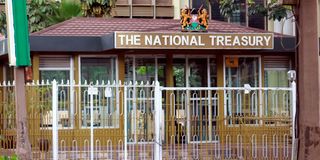State subsidy spending jumps eight-fold on costly commodities

The National Treasury Building in Nairobi. National Treasury data shows that President William Ruto’s administration spent Sh43.9 billion in the first quarter of the financial year 2022/23 on subsidies, more than eight-fold the Sh5.6billion spend in a similar period of last year.
The amount of cash spent by the State on fuel and fertiliser subsidies jumped eight-fold in the quarter to September, compared to a similar period last year, propelled by high prices of the commodities.
National Treasury data shows that President William Ruto’s administration spent Sh43.9 billion in the first quarter of the financial year 2022/23 on subsidies, more than eight-fold the Sh5.6billion spend in a similar period of last year.
The expenditure in the first quarter of the current financial year is also nearly twice the Sh22.2 billion that was budgeted for subsidies for the entire fiscal year, underlining the constant increase in prices of basic commodities that has forced the government to step in to provide relief to consumers.
The prevailing high cost of fuel has been a major burden to Dr Ruto’s government contributing the largest amount to the subsidy expenditure. The subsidy alone costs the government some Sh8 billion monthly depending on fuel consumption during the month.
A litre of petrol is now retailing at Sh177.3 in Nairobi after the Energy and Petroleum Regulatory Authority (Epra) cut the prices by Sh1 in last week’s monthly prices review, diesel is retailing at Sh162 and kerosene at Sh145.94.
Cross-subsidizing
To reduce its subsidy burden, however, the government has been cross-subsidizing the three fuel products.
The price of a litre of petrol is Sh9.94 above the market price to help bring down the cost of diesel, while a subsidy of Sh17.68 per litre was maintained on kerosene.
“The price of diesel has been cross-subsidized with that of super petrol while a subsidy of Sh17.68/litre has been maintained for kerosene in order to cushion consumers from the otherwise high prices,” said Epra Director-General Daniel Kiptoo.
The government has also spent billions to subsidise fertiliser to boost production amid high costs of farming input which is among the major factors that have contributed to low crop production leading to high food prices.
The government in September announced it had set aside Sh3.55 billion to subsidize 71,000 metric tonnes (1.42 million 50-kg bags) of fertiliser for growing crops to boost productivity.
The fertilizer was geared to support cultivation on about 1.4 million acres of land.
This comes as maize prices have shot up sharply this year due to the low local production.
Maize production declined by 12.8 percent in 2021 from 42.1 million bags in 2020 to 36.7 million bags in 2021 due to prolonged dry conditions for parts of the year.
The high expenditure on subsidies means Dr Ruto is following in the footsteps of his predecessor Uhuru Kenyatta, who spent Sh67.17 billion in subsidies for key commodities in his last four months in office.
Consumers could however be hit by higher commodity prices should Dr Ruto follow through with plans to gradually wean consumers off the subsidies to reduce the fiscal burden on the exchequer.
Hit with a biting cash crunch, Dr Ruto has embarked on a multi-pronged strategy to cut non-essential expenditures, cut subsidies and raise revenue collection to fund his key campaign promises.
The President has already instituted a Sh300 billion budget cut for the Sh3.3 trillion budget or the current fiscal year targeting spending on items such as entertainment, public relations, operations and maintenance, and travel.
The Head of State is betting that the short-term pains that will hit consumers on the withdrawal of subsidies will result in long-term gains through the diversion of the subsidies in the local production of food to lower prices.
This as the government explores other short-term measures that can lower the cost of living, with the State for the first time approving the cultivation and importation of genetically modified (GM) maize to address shortages in the local market.
Trade Cabinet Secretary Moses Kuria announced the decision last week pending the issuance of a gazette notice authorizing the importation of 10 million bags of both organic and GMO maize duty-free for six months.
High food, transport, and household commodities’ prices elevated the country’s inflation further to a 5.4-year high of 9.6 per cent in October, highlighting the pain households continue to endure in the face of a worsening cost of living.
The last time Kenya’s inflation crossed the current figure was May 2017, when it hit 11.7 per cent.





